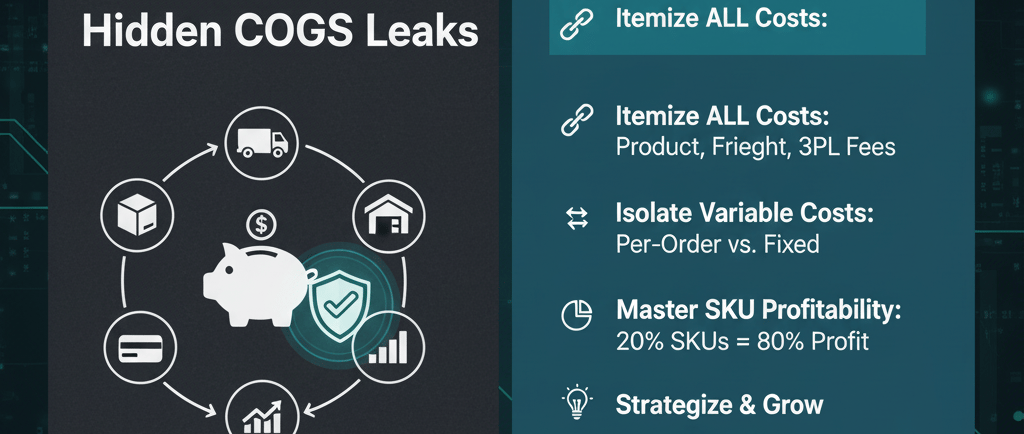🇺🇸 The US E-commerce Profit Blueprint: How to Fix Your Hidden COGS Leaks
For US e-commerce store owners and Shopify sellers, your most crucial experiments aren’t just in advertising or product development they are in your financial data. Mastering your numbers is the key to sustainable eCommerce profit margins.
10/25/20252 min read


Jeff Bezos once said: “If you double the number of experiments you do per year, you’re going to double your inventiveness.”
For US e-commerce store owners and Shopify sellers, your most crucial experiments aren’t just in advertising or product development they are in your financial data. Mastering your numbers is the key to sustainable eCommerce profit margins.
When a client came to Clearlyze, they were generating over $500k in US sales but their profits were vanishing. They didn't have a marketing problem; they had a Cost of Goods Sold (COGS) problem. Their COGS was incomplete, murky, and hiding their true financial performance.
We applied the core Bezos mindset: start from the customer and work backward through every single cost to achieve maximum profit optimization.
🧾 Step 1: Break Down True COGS for Accurate US Retail Accounting
Most online stores only track the simple “product cost.” However, for accurate US retail accounting, true COGS must include all direct costs per unit. This comprehensive breakdown ensures compliance and reveals your real cost structure:
Product Cost: The base wholesale price.
Freight and Duties: Crucial for imports into the US market.
Packaging Materials: Per-order costs for boxes, tape, and inserts.
Fulfillment & 3PL Fees: Direct costs from your 3PL provider.
Payment & Platform Charges: Non-negotiable fees (e.g., from Shopify, Stripe, or PayPal).
We itemized each expense per SKU. Why? Because a shallow COGS calculation is a form of deception that leads to poor business decisions.
📦 Step 2: Isolate Variable Costs for Better Financial Forecasting
Next, we separated the variable costs (which change with sales, like shipping and packaging) from fixed overheads (salaries, rent, software).
This simple step is vital for financial forecasting. It instantly showed our client their breakeven point per order, revealing that growth in sales volume didn't always translate into a growth in net earnings. This clarity is essential for managing eCommerce cash flow.
📊 Step 3: Master SKU Profitability (The 80/20 Rule)
We created a product-level Profit and Loss statement. That’s when the profit truth appeared: 20% of the SKUs were generating 80% of the profits, while a significant portion were silently losing money on every sale.
By strategically trimming the low-margin products and doubling down on the winners, the brand instantly improved its overall eCommerce gross margin. This level of SKU profitability analysis is mandatory for all high-growth US e-commerce brands.
💰 Step 4: Reinvest with Financial Clarity
With accurate, GAAP-compliant COGS data, our client was finally confident to make smart decisions. They used their financial clarity to:
Renegotiate supplier terms based on real cost targets.
Adjust pricing strategically across their entire catalog.
Redirect ad spend only toward the most profitable items (high-margin SKUs).
The result? Profit increased substantially not from sheer sales volume, but from precision eCommerce cost management and financial visibility.
This is the power of the financial approach: clarity, iteration, and precision. It always starts with a simple question:
"As a US store owner, do I truly know the all-in cost of every product I sell?"
If you don’t, you're running your business with blurred vision and a leaky profit bucket.
📩 Message Clearlyze to get your Free COGS Breakdown Template your first step toward unlocking true eCommerce profit optimization today.
✨ Clearlyze — Turning Complex eCommerce Financials into Clear Growth Stories for US Retailers.
© 2018-2025. All rights reserved.
Clearlyze
Quick Links
Meet our Team
Blog
Contact
For Support & inquiries:
📧 team@clearlyze.com
🌍 Serving Clients Worldwide
Accounting Calculators
